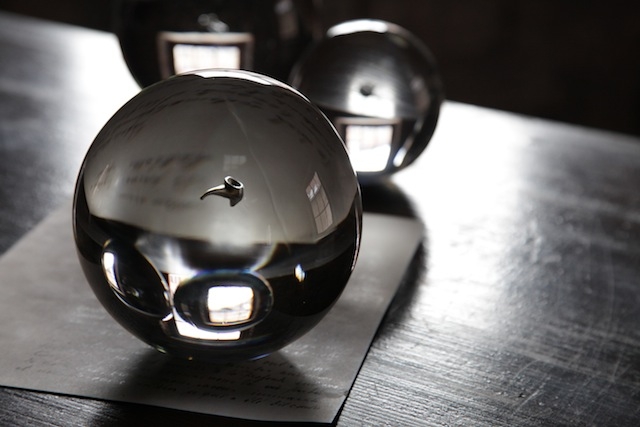Ikon, Birmingham 15 March – 4 June
Galerie Thaddaeus Ropac, London 28 April – 29 July
An ominous swelling of voices draws you down the bright, formal corridor. Four men stand facing into the corners under and opposite a central stairway, as if they’re being punished for misbehaving. But they’re singing: steady tones, occasionally rising, echoing and merging to the point where it starts to make your head swell a bit. A shiny copper etching informs us this grandiose performance is Oliver Beer’s Composition for London (2017), part of his exhibition at Thaddaeus Ropac’s swish new Mayfair gallery. It’s the latest iteration of Beer’s Resonance Project, which, since 2007, has used the human voice to find the resonance frequencies of rooms and buildings across the world. The voices are joined by other sounds – other notes, ringing in your ears, the building itself becoming an unusual additional choir member standing over you. This dramatic swell has an immediate sensual impact, though it struck me more as the soundtrack to a horror movie, hearing it while walking down such an ornate white corridor – I was having unwelcome flashbacks to when I accidentally saw Don Coscarelli’s Phantasm (1979) as a seven-year-old (it includes scenes of a silver orb zooming down just such a hallway to gouge into victims’ heads). Then the performance ended: one member of the small audience clapped politely, the rest shuffled off silently as if in church.
Further into the gallery is another odd choir, altogether inhuman: Devils (2017), consisting of a set of miked-up pots, urns, vases and teapots on plinths, amplifies and resounds certain frequencies to create a more tense polyphony. You can, at times, make out the high note of a ceramic cockerel, or the more temperate hum of a cat teapot. Another of Beer’s resonance installation works is simultaneously on display in his show at Birmingham’s Ikon Gallery. Making Tristan (2016) uses a chamber pot and a ceramic pig to reproduce the dissonant chord known from Wagner’s opera Tristan and Isolde (1859), its uneasy whine permeating the entire exhibition and giving the grimacing, squatting pig the air of defiantly shitting in your ears. These resonance works, using buildings and ancient and hand-me-down vessels as singers, are Beer’s most directly engaging works; which must be why it is a gesture to which he has continually returned, including making them the most prominent components of both these shows.
Blandly performed notions of sonic experience limply enact musicality without exciting anything further in either the ear or the mind
Unfortunately, however, these works are undermined by the clutter that he surrounds them with. Much of these are more token, superficial takes on Beer’s loose thematic exploration of sound. The Birmingham show includes two organ pipes emitting the highest and lowest notes possible on the instrument, along with a video in which Beer’s mother sings a single note while subtitles lecture on basic music-theory concerning complementary notes; as well as large glass orbs that contain small golden replicas of parts of the inner ear, titled – wait for it – Silence is Golden (2013). These blandly perform notions of sonic experience and limply enact musicality without exciting anything further in either the ear or the mind.
Worse, though, is the ongoing series permeating both the Birmingham and London shows in which the artist has cut cross-sections from objects and embedded them in the wall or in canvaslike rectangles of gesso. Starting with two violins in Recomposition (We Two Boys) (2017) and a double bass in Double Bass Drawing (2017), they might, if we’re feeling buzzed from the melodramatic choral sounds, be seen as similar singing bodies, the flat outlines letting us look at the cavities once filled with sound. But then he’s also done it with SLR cameras, pipes, lightbulbs, rifles, revolvers, pencils, tuning forks and walking sticks. These two-dimensional objects are cute, and utterly pointless. What they make clear is that Beer is more concerned with surface than content, with affect than effect.
The works cumulatively set us awash in sounds and textures, seemingly oblivious to their own import and implications, flattening individual traumas and histories to prop up idealised, aesthetic ends. At Ikon, one of the walking sticks is embedded high in the ceiling: the first narrative I imagined to explain its placement was that its user had tripped, falling and throwing the cane into the air. In the video Training (2008), we see a set of young people listening intently to a recording of a woman confessing to having been abused by her uncle as a child; the story of rape, written by Beer, is remarkably just a pretext for him to record the reactions on the listeners’ faces. Beer’s bodies and vessels aren’t just neutral containers, as he treats them, but singular entities, with their own songs to sing.
From the Summer 2017 issue of ArtReview
